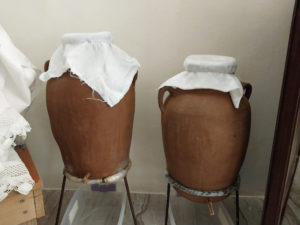Ambriss, jar white cheese of the Bekaa valley

Renowned for the richness and diversity of its terroirs, the Bekaa Valley exhibits, in the North, stretches of land that are hostile to agriculture because of their poor soil, dry climate, and rugged terrain. This land, which is not used for agriculture, is used for livestock, particularly sheep and goats. Goat and sheep-herding families are numerous in this region.

The preparation of ambriss or jar labneh is an ancestral practice passed down from mother to daughter. From June to November, women engage in production cycles that last several days. First, a mixture of fresh goat and sheep milk and salt is poured into a clay, glass, plastic, or porcelain khabyeh jar with a hole at its base. The hole is plugged with a small tree branch or tap. The mixture ferments for 5 days, at the end of which the hole or tap is opened to empty all the plasma contained in the jar over 24 hours. This process, known as bazel, is repeated every three days. The warmer the weather, the faster the fermentation process. The jar is thoroughly cleaned every day. It is then well covered with a piece of white cloth to prevent flies from settling on it or worms from proliferating. It is also recommended not to use odoriferous products near the jars or have hands that smell of garlic and onion.
The ambriss is only consumed after the fifth plasma emptying, as it will not have fermented properly and acquired the desired taste before then. It is completely emptied from the jar at the end of the sixth month to be filled into containers for the winter provisions. The jar is part of the heritage of the northern Bekaa. Present in almost every home, it is protected from the persistent gaze of an envious eye that could alter the quality of the milk. Belief in the evil eye, known as ayn, prompts women to place ambriss jars in places not exposed to the eyes of curious onlookers. This helps ward off the power of the evil eye. Some women also hang a bead in the shape of an eye on the jars. This talisman is supposed to reflect the evil gaze of the envious people.
Ambriss is a staple in the diet of the region’s inhabitants, as they rely on it, especially during the long winter months, instead of buying labneh. It is also sold in the local market, serving as a supplementary source of income for the domestic economy.

